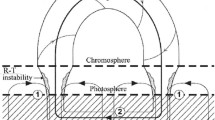Abstract
A simplified analysis of helmeted coronal structures is carried out and some of the gross properties of such structures discussed. It is found that the magnetically closed region can have but a limited extension into the corona. For temperatures in excess of 1.5 × 106 °K, the maximum height above the limb is about 1.6 R ⊙. The maximum possible extension of the helmet from the solar center is exactly one-half the distance to the critical point (where the flow velocity passes through the speed of sound). For this reason, a helmet streamer, at least out to a few solar radii, is essentially a magnetostatic structure - the flow adjacent to the helmet having little effect upon its properties. For given base dimensions, there is a maximum temperature for which a helmet streamer can exist - giving an indication of why such streamers do not appear over young active regions. If the temperature in the helmet and in the streaming region are approximately the same, the helmet height, helmet shape, external flow velocity, and rate of outward decline in the magnetic field are shown to be much more dependent upon the photospheric field distribution than upon the field strength. The density enhancement, however, is a strong function of the field strength. This enhancement is preserved out to the top of the helmet with both the density inside and outside decreasing approximately as predicted by hydrostatic equilibrium. The possible existence of both domed helmets and cusped helmets is demonstrated with the former existing at lower temperatures and the latter at higher temperatures. Cusped helmets occur, however, over a relatively narrow temperature range and are, hence, expected to be less common. The expansion velocity outside the helmet is higher than that predicted by radial flow but increases outward much more slowly. The magnetic field decreases outward proportionally to the square root of the density and inversely proportionally to the velocity - bearing, in general, no relation to a potential field since the rate of decline in field strength is determined by the temperature.
Similar content being viewed by others
References
Billings, D.E.: 1966, A Guide to the Solar Corona. Academic Press, New York.
Bugoslavskaya, E.Y.: 1949, Pub. Sternberg Inst.
Hepburn, N.: 1955, Astrophys. J. 122, 445.
Michard, R., Dollfus, A., Pecker, J.-C., Laffineur, M., and D'Azambuja, M.: 1954, Ann. Astrophys. 17, 320.
Newkirk, G. Jr.: 1961, Astrophys. J. 133, 983.
Newkirk, G., Jr.: 1967, Annual Review of Astronomy and Astrophysics, Vol. V. Annual Reviews Inc.
Parker, E.N.: 1958, Astrophys. J. 128, 664.
Pneuman, G.W.: 1966, Astrophys. J. 145, 242.
Pneuman, G.W.: 1967, Solar Phys. 2, 462.
Pottasch, S.R.: 1960, Astrophys. J. 131, 68.
Schmidt, M.: 1953, Bull. Astron. Inst. Neth. 12, 59.
Takakura, T.: 1966, Space Sci. Rev. 5, 80.
Van de Hulst, H.C.: 1953, in The Sun (ed. by G.P. Kuiper). University of Chicago Press, p. 207.
Author information
Authors and Affiliations
Additional information
On leave from AC Electronics Research Laboratories Santa Barvara, Calif., U.S.A.
Rights and permissions
About this article
Cite this article
Pneuman, G.W. Some general properties of helmeted coronal structures. Sol Phys 3, 578–597 (1968). https://doi.org/10.1007/BF00151939
Received:
Issue Date:
DOI: https://doi.org/10.1007/BF00151939




